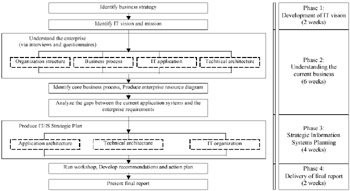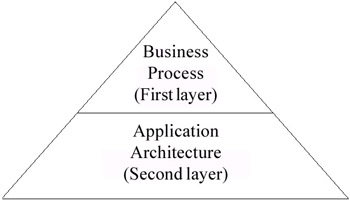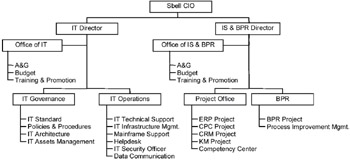CASE DESCRIPTION
|
|
At the beginning of the project, the team members, particularly employees within Sbell, did not have a clear understanding of SISP, and had little knowledge of how SISP can benefit the company and how to develop a strategic plan. Hence, the consultants spent about a week to train the employees in SISP approach.
The project manager of consulting company B, indicated:
"A strategic information systems plan for Sbell, can be seen as a vision with directional statements, and comprises a set of both broad and detailed guidelines that provide a framework for strategic, tactical and operational decision-making. An IS strategy should also clearly link the IS goals to the strategy of a business, and provide a detailed blueprint for the acquisition, development, deployment and retirement of IS/IT assets over a multi-year time horizon."
A strategic IS plan, according to Sabherwal and Chan (2001), comprises three types of strategies: Information Systems (IS) strategy, Information Technology (IT) strategy, and Information Management (IM) strategy. IS strategy focuses on systems or business applications of IT, and is primarily concerned with aligning with business needs to derive strategic benefits. IT strategy is concerned mainly with technology policies, including architecture, technical standards, security levels, and risk attitudes. Finally, IM strategy is concerned with the roles and structures for the management of IS and IT, and is focused on issues such as the relationships between the specialists and users, management responsibilities, performance measurement processes, and management controls (Earl, 1989).
The two consulting companies jointly carried out a four-phase approach (as shown in Figure 6) to accomplish the SISP project's objectives:
-
Phase 1: Development of IT vision (2 weeks)
-
Phase 2: Understanding the current business (6 weeks)
-
Phase 3: Strategic Information Systems Planning (4 weeks)
-
Phase 4: Delivery of final report (2 weeks)

Figure 6: Strategic Information Systems Planning Process
For simplicity, the SISP development process was depicted in Figure 6 as a linear flow of events. However, it would be more realistic to have a number of feedback loops included in the diagram. For example, while producing the IS plan in phase 3, the planners frequently returned to phase 2 to interview specific employees to obtain additional information.
The details of the four-phase approach will be discussed in the subsequent sections.
Phase I: Development of IT Vision
The focus during the first two weeks of April 2001 was on understanding, identifying and documenting the IT vision. It was recognized that IT should support the basic goals of the firm, thus the first thing needed was to identify the business strategy. Several interviews were conducted at the top management level to understand strategic and organizational issues concerning short-term and long-term business goals, organizational reengineering, and IT evolution to support the necessary organizational change.
Mr. Xin Yuan, the associate chief executive manager summarized the weaknesses of Sbell as: weak in research and lack of innovative and cooperative culture within the company. "In order to survive in today's business environment and to become a global leading high-tech company," he continued, "we urgently need to strengthen Research and Marketing, which would contribute significantly to our core business competencies. Therefore, we propose changing from our current spindle structure, which focuses on manufacturing, in the middle part of the spindle, to a dumbbell structure, which focuses on research and marketing at the two opposite ends of the dumbbell."
Based on an analysis of the information gathered from the interviews, the team delivered an IT vision report outlining the enterprise environment, business strategy, IT vision, and alignment between business strategy and IT vision.
Phase II: Understanding the Current Business
"One of the most important objectives of Phase 2," emphasized by Mr. Ziqiang Pan, the project manager of consulting company A, "is to identify the critical business process of Sbell." He continued to explain, "Core business processes are those activities flowing through the value chain of the company. They are stable and not easily affected by the external environment. Identification of core business process is the foundation for understanding the current business needs and the gaps between those needs and the functionality provided by existing IT applications. We can therefore determine the potential application opportunities and priority of application development portfolio."
Starting the middle of April, the project team was divided into five groups to conduct a six-week survey, which included a series of interviews and a semi-structured questionnaire. The objectives of this survey are two-fold: (1) to identify the current business process, and (2) to gain a better understanding of the organization, and its technical architecture and application systems. The five groups corresponded to the five business areas:
-
manufacturing and procurement;
-
research and development;
-
sales, marketing and service;
-
functional departments; and
-
business divisions.
Each group, comprising one or two consultants working jointly with several Sbell employees, conducted interviews and administered questionnaires in the specific business area. These employees played an active role in bringing the consultants and Sbell employees together.
A series of interviews were conducted at the middle management level. Several meetings were held between the project team members, and the managers and representatives in the respective departments. The interviews provided the planners with an understanding of the core business process within each department, the functionality provided by existing application systems, and the future IT/IS needs of the departments. Communications between the planners and the employees also provided opportunities for employees to clarify the purpose of SISP and its approach.
The planners also administered a semi-structured questionnaire to representatives from each department. The questionnaire comprised four major parts:
-
Business process—concerned with relationships between processes, average execution time of each process, number of participants involved in each process, available IT support, major activities, and input and output information of each activity.
-
Organization and management—concerned with department objectives, organizational structure, human resources and IT resources, as well as the relationships and cooperation among units within and outside Sbell.
-
IT application—concerned with limitations of existing information systems, cost of each IT application, development methods (in-house or out-sourced), names and functions of each module, the scope and boundaries of business processes supported by each application, and interfaces among those applications.
-
Technical architecture—concerned with current IT infrastructure, platform, database and network.
At this stage, the planners spent a lot of time on collecting documentations of business processes, seeking information on undocumented but critical activities, and then combining information produce an overall view of the enterprise. This work was labor intensive and time-consuming. On one hand, the planners had to take much effort to check for accuracy of the core processes since inconsistencies might exist between the process presented in the "official" documents and those carried out in practice. On the other hand, the planners had to communicate frequently with on-site employees to seek information on undocumented but critical activities, and then produced a formal documentation (business process diagrams) based on the employees' description of their day-to-day operations.
Day-to-day operations in such a big company were so complex that the planners met many challenges. First, they found that the business processes were unstable with respect to ownership. Because of frequent organizational adjustment, work that was done by department A today might be carried out by department B tomorrow. Second, the more in-depth the survey, the more they found unclear boundary and ambiguous relationships among some of the processes.
Facing these problems, the planners decided to take a break and to discuss these issues. First, was it necessary to depict ownership as part of the business process? Organizational structure (people) is easily affected by the external environment and internal innovations, while operations, especially the core business processes of the company, would remain stable no matter who does it. Therefore, analyzing activities by ownership is not worthwhile for obtaining a stable view of the enterprise. Second, how in-depth should the planners analyze these processes? At what level of detail was it sufficient for producing the strategic plan? Realizing that the objective of analyzing business process in this case was for IT/IS strategic planning, rather than to produce an implementation design, the planners felt it would sufficient to identify the core business process, capture the general activities for each process, and more important, realize activities not supported by IT applications. Third, how should planners deal with those problems, such as information conflict and process redundancy, found in the analysis procedure? Considering that this was an SISP project, not a BPR (business process reengineering) or BPI (business process improvement), the planners decided to document the problems and provide recommendations to the company for future improvement. In this way, the planners could save time and avoid being involved in political issues such as power struggle.
By the end of May 2001 (after six weeks of hard work), the planners presented an enterprise information resource diagram showing a snapshot of the existing information resource of the enterprise. Eight core business processes were identified, including manufacturing, procurement, research and development, marketing, service, sales, human resources and finance. Among them, manufacturing, procurement, finance and part of sales & marketing were supported by the ERP system; human resource was supported by an out-sourced software; and research & development almost gained no support from application systems.
The enterprise information resource diagram is a two-tier model (shown in Figure 7).

Figure 7: Enterprise Information Resource Diagram
The first layer of the enterprise information resource diagram depicts business processes that were identified through the survey. Application architecture, the second layer, describes the application systems that support specific business operations. Different colors were used to indicate different application systems that provided support for specific business processes. Therefore, from the two-layer diagram, it became fairly easy to identify the business processes that were covered by the application systems, and those that were important but only partially supported or not supported by any application.
Phase III: Strategic Information Systems Planning
At the beginning of June 2001, it was time for the planners to produce a strategic IT/IS plan. The project team was divided into three groups to work on the following three areas: application architecture strategic planning, technical architecture strategic planning, and IT organization strategic planning. Much emphasis was placed on the application strategic plan; since it was considered the most critical area that needed a lot of work, nearly two-thirds of the team members participated in this group.
Application Architecture Strategic Planning
Application architecture comprises the set of IT applications (bought or built) that delivers the business process, and the technology (i.e., middleware) that integrates the various applications and links them with a coherent data model.
The enterprise information resource diagram was represented on "post-it" notes and stuck onto the walls of a conference room for others to view, critique, and make suggestions for modifications. Several employee representatives were invited to comment on the correctness and accuracy of the diagram.
First, the planners tried to identify potential application opportunities from the enterprise diagram. They found that finance and human resources were well supported by the application systems. Although manufacturing and procurement were generally covered by the ERP system, information inconsistency existed, thus system optimization was needed. Sales, marketing and service were partially supported by the ERP system and some isolated small-scale systems; research and development obtained almost no support from the IT systems. It seemed Sbell was in urgent need of the following: application for R & D (Collaboration Product Commerce or CPC), and application for sales and marketing (Customer Relationship Management or CRM), and optimization of the ERP system. Other application systems, such as e-procurement and knowledge management were also potential applications. CPC is a new type of software and services that uses Internet technologies to tie together product design, engineering, sourcing, sales, marketing, field service and customers into a global knowledge net (Aberdeen Group, 1999). CPC can facilitate management of product life cycle and cooperation with external partners. CRM is an integrated customer-oriented system concerned with sales management, marketing information acquisition and service improvement. Since service and support would become the competitive edge of Sbell, developing CRM would provide opportunities for Sbell to establish a closer collaboration with partners, suppliers and customers. ERP optimization includes integrating current stand-alone systems, developing additional modules, improving user training, and strengthening ERP support team. These ways can greatly increase the efficiency of the SAP R/3 system.
Next, prioritization of projects was considered due to the limited resources. The key question is: Which project was the most urgent for Sbell and should be implemented first, and which should be implemented next? The planners considered many factors in making a final recommendation. These factors included the business strategy, alignment with Alcatel (the potential merger), IT vision, budget, cost, time, technical complexity and technology trends.
Among the potential application systems, CPC was regarded as top priority for the following reasons:
-
Lagging behind in advanced communication technology, Sbell faced the danger of decreased market share due to increased competition from both foreign companies and rapidly-growing local companies. Therefore, increasing the capability of research and development became crucial for survival and future development of Sbell.
-
There was a high likelihood that Alcatel would acquire Sbell by becoming a majority shareholder and develop Sbell as one of its major global information technology research centers. Therefore, Sbell should build an advanced R & D platform to meet the anticipated challenge.
-
Compared to marketing and sales, R & D was considered more urgent and crucial in its needs for IT support. Sbell has a well-organized sales force. Some operations in sales were supported by isolated or shadow systems. Although the functionalities provided by IT applications were inadequate, the system can handle basic operations. In comparison, R & D obtained little support from IT and was considered the weakest part of the company. Therefore, improvement of sales & marketing was necessary but not considered as urgent as improvement of R & D.
Other issues were also addressed in application architecture planning, such as application development alternatives (e.g., buy or build), application vendor selection, budget and implementation schedule.
Technical Architecture Structure Planning
The technical architecture is the foundation upon which the application architecture was built. The technical architecture should be further decomposed into "layers," such as application systems, database, IT service, network and platform.
Based on an in-depth survey of the current technical infrastructure conducted at the earlier phase, the planners collected detailed data and information in computing infrastructure, network infrastructure, and enterprise IT service.
A workshop was held with IT managers and users to develop a technology specification for Sbell's strategic architecture. The topics included: IT principles, platform/operating system(s), network infrastructure, middleware infrastructure, systems/network management, security infrastructure, and IT services.
After several discussions and changes, the group conducted a review session to finalize the written report detailing the IT mission, business drivers, IT principles, technology standards, and specific technology frameworks that would guide Sbell in the implementation and deployment of enterprise-wide technology and its next generation application systems.
Organizational Strategic Planning
The organizational architecture is the remaining component, which is important but often ignored in practice. The organizational architecture refers to the IT organizational structure, as well as the set of management processes or governance rules.
A series of interviews were conducted to understand the organizational and management processes in order to align the IT organization and management processes with the business strategy. The group first analyzed the current IT organization and compared it with other advanced IT organizations, and then presented a series of suggestions for IT organizational structure and project management. A workshop, which was primarily attended by management personnel, was held to present and discuss the results. The review was one day in duration and was held at Shanghai Bell's headquarters.
Phase IV Delivery of Final Report
Several review sessions were held among the consultants and the employees of Sbell to achieve consensus of the final report. A vote was taken by the top management during an application strategic planning workshop to determine the priority of potential IT applications.
The results of all phases were consolidated into a formal final report that documented the strategic and operational plans for IT development. The report addressed the following areas: business strategy and IT drivers, IT vision and mission, application architecture strategy, technical infrastructure strategy, and IT organization and management strategy. Application architecture strategy included a three-stage operational schedule for the implementation of information systems, including a potential list of applications, the priority of these applications, and recommendations on development alternatives (out-souring or in-house), vendor selection and budget. Technical infrastructure strategy and IT organization strategy provided recommendations for technical framework and construction of IT organization in Sbell.
In the middle of July 2001, after five-month of close cooperation, the project team presented a final report to Shanghai Bell's executive management at its headquarters. In summary, the suggestions included:
-
ERP optimization, CPC, and CRM were absolutely necessary for Sbell. Among them, ERP optimization and CPC were of the highest priority and needed immediate attention, while CRM was to be carried out next.
-
Establishing an independent and centralized IT organization (shown in Figure 8) is essential. This organization should be directed by the CIO and should comprise both an IT department and an IS department.

Source: Shanghai Bell Corporation
Figure 8: Sbell IT/IS Organization Chart (To-be) -
Building a distributed technical architecture that utilized advanced network technology.
|
|
EAN: 2147483647
Pages: 367